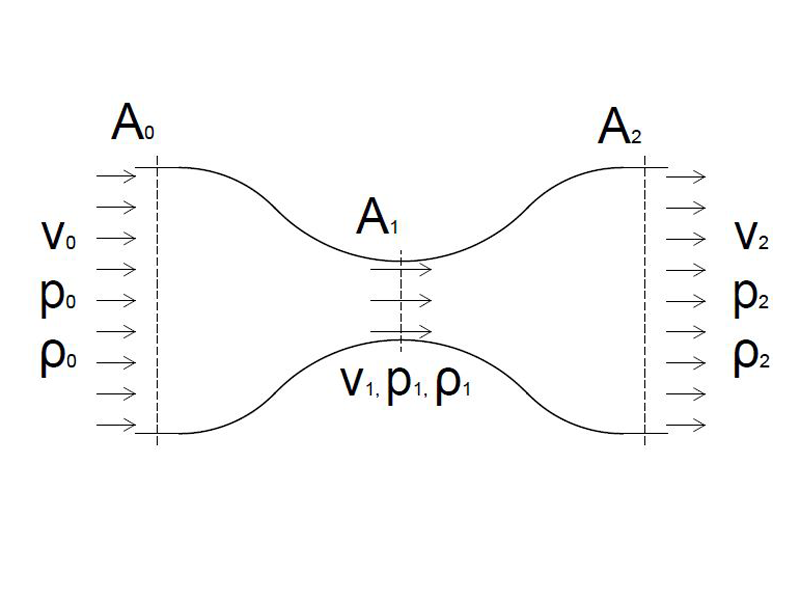The so-called “Venturi effect” is a physical principle according to which a fluid that moves inside a conduit increases or decreases its pressure according to its speed.
This characteristic was discovered in the 19th century by the Italian physicist Giovanni Battista Venturi, during some research on fluid mechanics, and it is still used today as one of the most common methods to measure velocity (Venturi tube).
The physical principle
When a fluid flows inside a duct that shows no leakage, the fluid keeps its mass constant (also called mass conservation principle).
since we are talking about a fluid in motion we can extend the principle of conservation of the mass, to the flow of the fluid; therefore, if we measure 100 m3/h of air at the inlet section of the duct, we will measure the same value at the output section.
If we imagine that the conduit does not have a constant section, the fluid passing through it will change its speed according to the passage section in which it is located.
It is easy to imagine the following: if a certain airflow Q ̇, which is constant, is passing through a large opening A0 its velocity v0 will be reduced, whereas if the same airflow Q ̇ I crossing a smaller opening A1 its speed v1 will be higher.
If inside the duct there is no device capable of supplying energy to the fluid, according to the principle of energy conservation, also this value will remain constant between the duct inlet and its outlet.
In order to better explain this principle it is necessary to consider the fluid that moves inside the conduit as an ideal fluid and apply to it the Bernoulli principle, that says: the sum of the kinetic energy (contribution provided by the velocity v of the fluid ), the potential energy (contribution provided by the change in height h of the fluid) and the pressure p remain constant along the conduit.
With all the simplified though it may be, and provided that the conduit is horizontal, we get the following result:
This formula expresses in mathematical terms the concept underlying the effect analyzed by Venturi:
In order to keep the overall energy of the fluid inside the duct constant, in the points where the velocity decreases, the pressure rises, whereas in the points where the fluid accelerates the pressure will decrease.
The application fields
The Venturi Effect is used daily in a multitude of applications; from spray cans, car carburetors, space rockets and even measuring instruments. It is in fact in the Venturi tube, used for the measurement of speed, that the phenomenon discovered in the 19th century finds its maximum expression.
Thanks to the formulation, it is enough to know the size of the section through which the fluid passes and the value of pressure before and after it in order to be able to determine its speed.
A concrete example: the EOC cone extractor
The Venturi effect is also used in the field of ventilation where the introduction of exhaust cones on the fans allows increasing their performance.
If we consider the working condition of a box fan, the fan is positioned directly between the inside of the shed and the external environment: in this condition it is working at a Δp equal to the difference between the external pressure (conventionally assumed equal to 0Pa ) and the pressure inside the shed (let’s consider for example -25Pa).

If we take a cone fan as a model, it is easy to observe that the fan is positioned between the inside of the shed and the narrow section of the cone.
In consideration of the above, we know that the air passing through the cone from the smallest to the largest section, will necessarily decrease its speed and therefore, due to the Venturi effect, the pressure in the narrow section will be lower than the one at the exit.
p1 < p2
So, assuming that the pressure inside the shed is equal to -25Pa, the fan will work on a Δp lower than the one of the box fan.
Δp = p0-p1
Δp < 25Pa
This condition means a saving in terms of energy absorption or, with the same absorbed energy, with better performance in terms of airflow.
Now you're are ready to discover our exhaust fans by clicking here
Read more:
